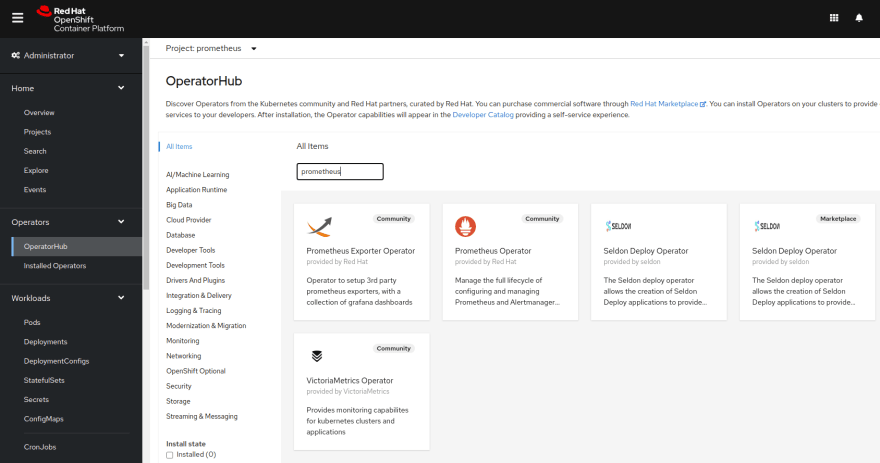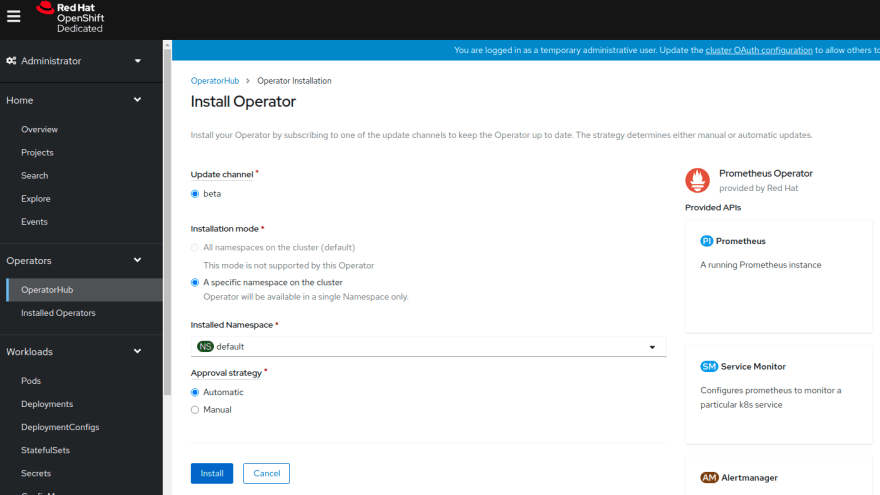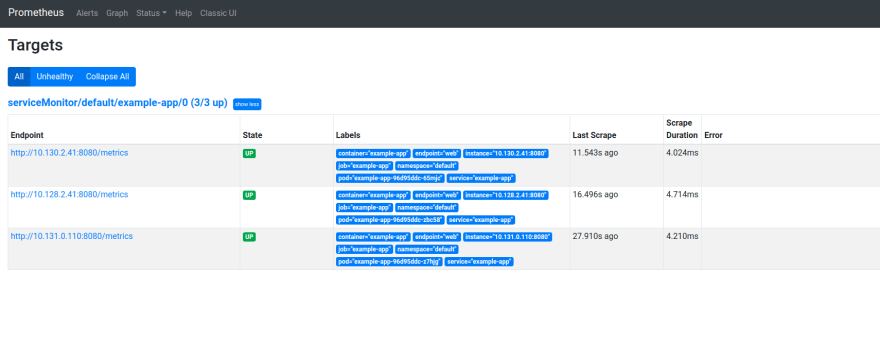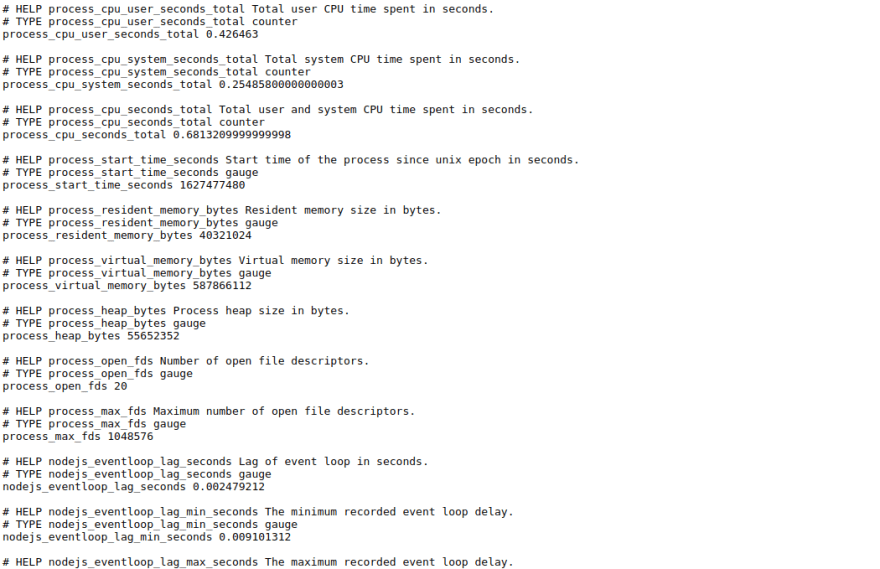24
Get Prometheus Metrics from a Express.js app
I use Prometheus all the time for metrics and alert monitoring in Kubernetes. I decided to see how to setup monitoring in a Node/Express.js app. A quick search of npmjs and I found these two package prom-client a really detailed Prometheus client and express-prom-bundle which uses prom-client under the hood, I choose express-prom-bundle as it was a quick win and was producing metrics with a few lines of code, my repo is here. I installed the following packages in my express app
npm install prom-client express-prom-bundle --saveThen added the Prometheus middleware to all routes
const express = require('express');
const app = express();
const promBundle = require("express-prom-bundle");
// Add the options to the prometheus middleware most option are for http_request_duration_seconds histogram metric
const metricsMiddleware = promBundle({
includeMethod: true,
includePath: true,
includeStatusCode: true,
includeUp: true,
customLabels: {project_name: 'hello_world', project_type: 'test_metrics_labels'},
promClient: {
collectDefaultMetrics: {
}
}
});
// add the prometheus middleware to all routes
app.use(metricsMiddleware)
// default endpoint
app.get("/",(req,res) => res.json({
"GET /": "All Routes",
"GET /hello": "{hello:world}",
"GET /metrics": "Metrics data",
"POST /bye": "POST Request: + post data"
}));
// hello world rest endpoint
app.get("/hello", (req,res) => res.json({hello:"world"}));
app.post("/bye", (req,res) => res.send("POST Request : "+ req));
app.listen(8080, function () {
console.log('Listening at http://localhost:8080');
});Running the app
npm start
> express-prometheus@1.0.0 start /home/austincunningham/repo/express-prometheus
> node index.js
Listening at http://localhost:8080
# curl the hello world endpoint
curl localhost:8080/hello
{"hello":"world"}%
# curl the metrics endpoint
curl localhost:8080/metrics
# HELP process_cpu_user_seconds_total Total user CPU time spent in seconds.
# TYPE process_cpu_user_seconds_total counter
process_cpu_user_seconds_total 0.120868
# I cut the metrics output short here as its a lot of text but you get the ideaI am using crc which is local Kubernetes development environment based on Red Hat Openshift. I create a container for the app based on the following DockerFile
# syntax=docker/dockerfile:1
FROM node:12.18.1
WORKDIR /app
COPY ["package.json", "package-lock.json*", "./"]
RUN npm install
COPY . .
CMD [ "node", "index.js" ]I then build, test the image locally and push the image
docker build -t quay.io/austincunningham/express-prometheus:v1.0.0 .
docker run -p 8080:8080 quay.io/austincunningham/express-prometheus:v1.0.0
Listening at http://localhost:8080
docker push quay.io/austincunningham/express-prometheus:v1.0.0I can then deploy this on crc/openshift with the following two files
deployment.yaml
apiVersion: apps/v1
kind: Deployment
metadata:
name: example-app
spec:
replicas: 3
selector:
matchLabels:
app: example-app
template:
metadata:
labels:
app: example-app
spec:
containers:
- name: example-app
image: quay.io/austincunningham/express-prometheus:v1.0.0
ports:
- name: web
containerPort: 8080service.yaml
kind: Service
apiVersion: v1
metadata:
name: example-app
labels:
app: example-app #--> this is used for scraping the service via the serviceMonitor
spec:
selector:
app: example-app
ports:
- name: web
port: 8080Apply the files to the default project
oc project default
oc apply -f deployment.yaml
oc apply -f service.yaml
service/example-app created
# create a route to the service so you can access from the browser
oc expose service example-app
route.route.openshift.io/example-app exposedI am following the prometheus operator getting started guide. Applied the bundle from the setup on the default namespace
oc project default
oc apply -f https://raw.githubusercontent.com/prometheus-operator/prometheus-operator/master/bundle.yamlNOTE: Hit a issue where the prometheus-operator pod was in a crash loop backoff :(
Openshift has an operator hub so I did the following to fix the crashing operator pod. First I deleted the existing prometheus-operator deployment
oc delete deployment prometheus-operatorLogged in to crc/Openshift console as kubeadmin, in the administrator view go to OperatorHub and search for prometheus

Select the Prometheus Operator tile and continue then select install button

Select the default namespace from the drop down and install button again

Phew! that took longer to explain that to do.
First we add the Prometheus CR(custom resource) to the default namespace to start the Prometheus instance
prometheus.yaml
apiVersion: monitoring.coreos.com/v1
kind: Prometheus
metadata:
name: prometheus
spec:
serviceAccountName: prometheus
serviceMonitorSelector:
matchLabels:
team: frontend # --> this is used by prometheus to scrape the serviceMonitor
resources:
requests:
memory: 400Mi
enableAdminAPI: falseAnd add the service
prometheus-service.yaml
kind: Service
apiVersion: v1
metadata:
name: prometheus-operated
namespace: default
labels:
operated-prometheus: 'true'
spec:
ports:
- name: web
protocol: TCP
port: 9090
targetPort: web
selector:
app: prometheusApply the files and create a route
oc apply -f prometheus.yaml
oc apply -f prometheus-service.yaml
oc expose service prometheus-operatedThe way Prometheus scrapes metrics is that it uses a service monitor to check a service for a particular label. We have already created the service when we deployed the example-app with the label app: example-app in metadata.labels.
Next we create a serviceMonitor in the default namespace and with a selector for the app: example-app label. So we create the following file.
service-monitor.yaml
apiVersion: monitoring.coreos.com/v1
kind: ServiceMonitor
metadata:
name: example-app
labels:
team: frontend # --> this should match the serviceMonitorSelector in the prometheus CR
spec:
selector:
matchLabels:
app: example-app # --> this should match the label in the service in example-app
endpoints:
- port: webNOTE metadata.labels
team: frontendwe will use this later.
We upload the service-monitor.yaml file to the default namespace to create the serviceMonitor
oc apply -f service-monitor.yamlIn the prometheus.yaml CR we have already selected the service monitor this is done via serviceMonitorSelector label with the label team: frontend
Finally we need some RBAC rules which is Kubernetes version of permissions to allow Prometheus to see everything
Setup a service account, clusterRole and clusterRoleBinding. Create the following files
service-account.yaml
apiVersion: v1
kind: ServiceAccount
metadata:
name: prometheusclusterRole.yaml
apiVersion: rbac.authorization.k8s.io/v1
kind: ClusterRole
metadata:
name: prometheus
rules:
- apiGroups: [""]
resources:
- nodes
- nodes/metrics
- services
- endpoints
- pods
verbs: ["get", "list", "watch"]
- apiGroups: [""]
resources:
- configmaps
verbs: ["get"]
- apiGroups:
- networking.k8s.io
resources:
- ingresses
verbs: ["get", "list", "watch"]
- nonResourceURLs: ["/metrics"]
verbs: ["get"]clusterRoleBinding.yaml
apiVersion: rbac.authorization.k8s.io/v1
kind: ClusterRoleBinding
metadata:
name: prometheus
roleRef:
apiGroup: rbac.authorization.k8s.io
kind: ClusterRole
name: prometheus
subjects:
- kind: ServiceAccount
name: prometheus
namespace: defaultApply the files to the default namespace
oc apply -f service-account.yaml
oc apply -f clusterRole.yaml
oc apply -f clusterRoleBinding.yamlYou should be able to access the route the default namespace
oc get routes
NAME HOST/PORT PATH SERVICES PORT TERMINATION WILDCARD
example-app example-app-default.apps-crc.testing example-app web None
prometheus prometheus-default.apps-crc.testing prometheus web NoneYou can open the Prometheus UI by adding a http:// to the Prometheus HOST/PORT returned from the oc get routes command

It takes a little while for the Prometheus operator to reconcile and to show up the new resources. In the Prometheus ui first check the Status\Service Discovery you should see example-app show up

NOTE: be patient it can take a while to show up
Then check the Status\Targets should see the following targets up

That it I may do a follow up on setting up Grafana to use these metrics
24


